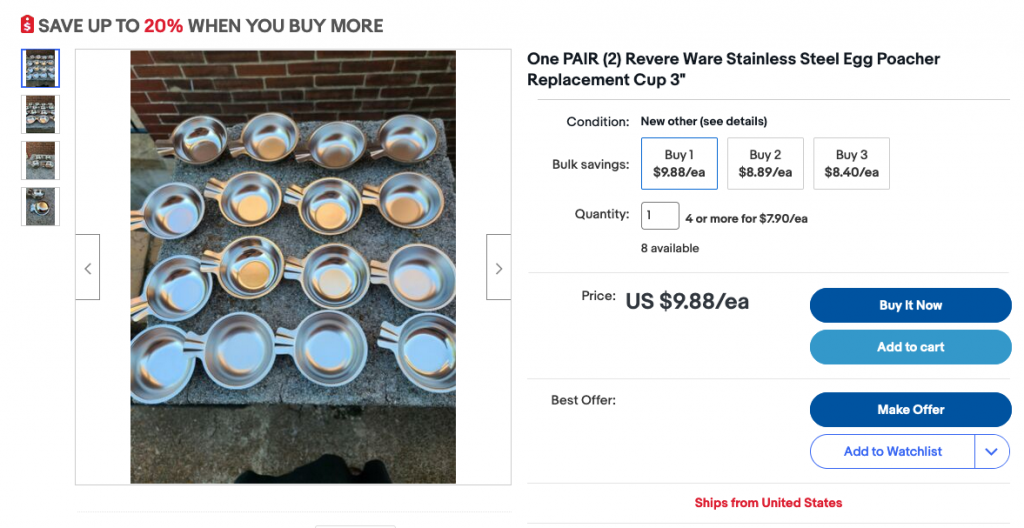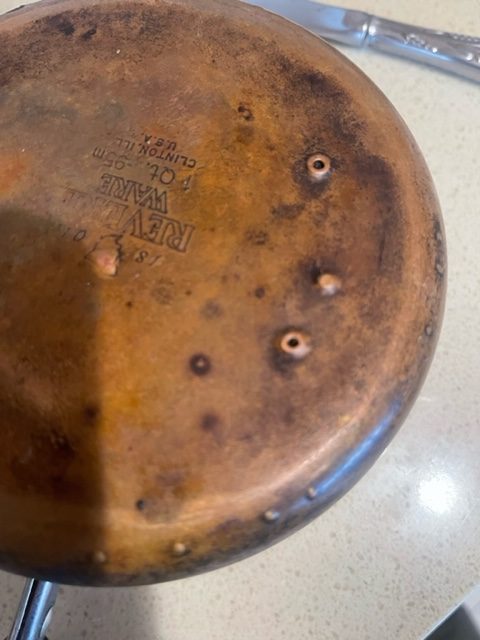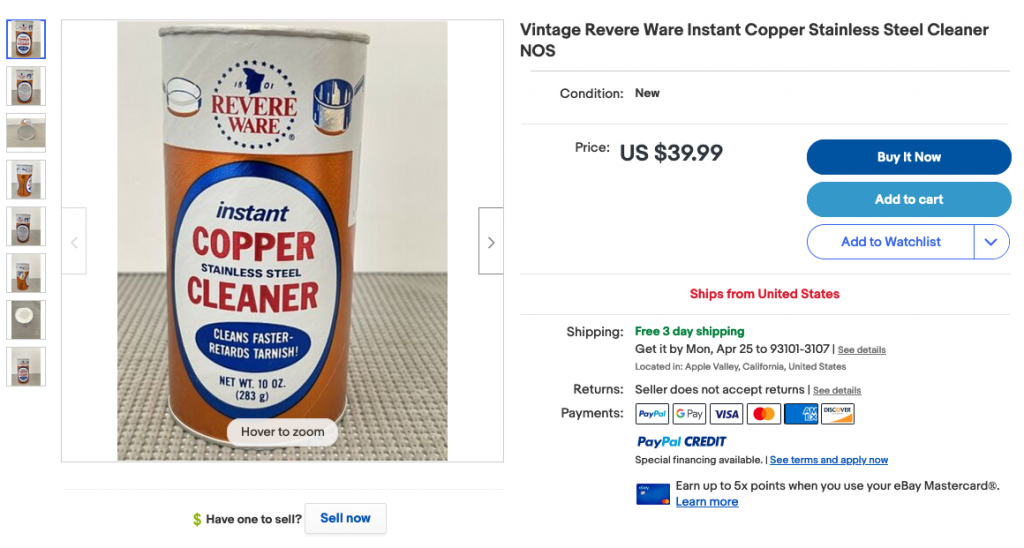Great source for egg poacher cups at a reasonable price. Won’t last long.
Archive | 2022
What is a brand new Revere Ware tea kettle really worth?
While I see exorbitant prices on new old stock items on eBay all the time, it is hard to tell whether or not people are actually willing to pay a really high amount for the privilege of experiencing new Revere Ware, especially because many of the items are from the 80’s and 90’s, when the quality of items was sub-standard, not exactly the glory days of Revere Ware.
So it is interesting to see an auction for a new in box tea kettle; an auction tells us what someone is actually willing to pay.
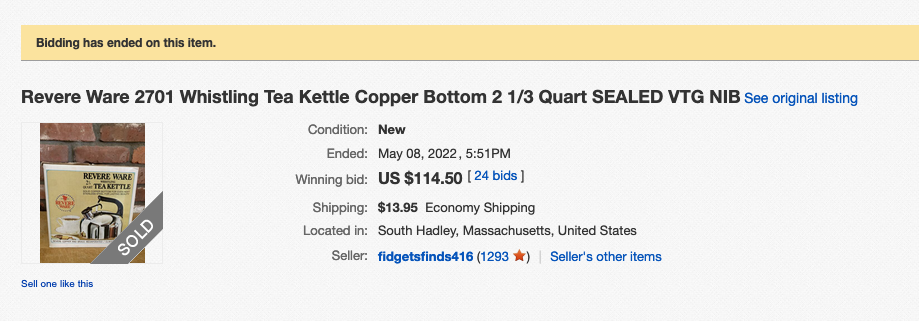
A clue to the age of the kettle can be found on the bottom of the box.
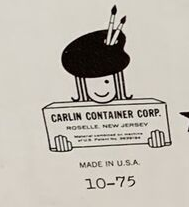
I take that as 1975. While Revere Ware might have started making the tea kettles with a thinner copper layer on the bottom after 1968, like they did with their copper bottom cookware, I’ve never found much difference in the pre and post-1968 era kettles, so 1975 is as good as any year in my mind.
Given the rarity of new Revere Ware kettles these days, $114.5 seems like a reasonable price to me. But that’s about 10 times what is originally sold for. 🙂
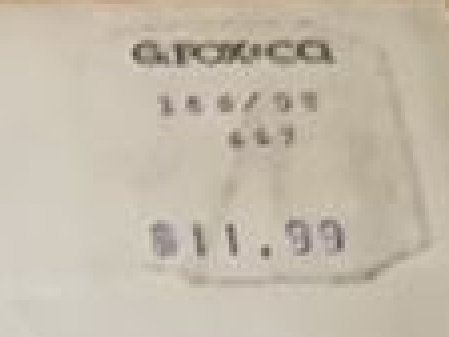
Copper bottom blistering
Reader Harold contacted us with this question:
My mother has some revere ware. I am noting some blistering on the bottom of the pan. Photo attached. What is causing this?
Revere Ware find of the week – brand new electric coffee pot
If you tend to wax nostalgic (like me) you’ll appreciate this brand new vintage electric coffee pot, I’m guessing from the 1970’s. Imaging unboxing this and making a nice cup of percolated coffee like you just brought it home from Sears.
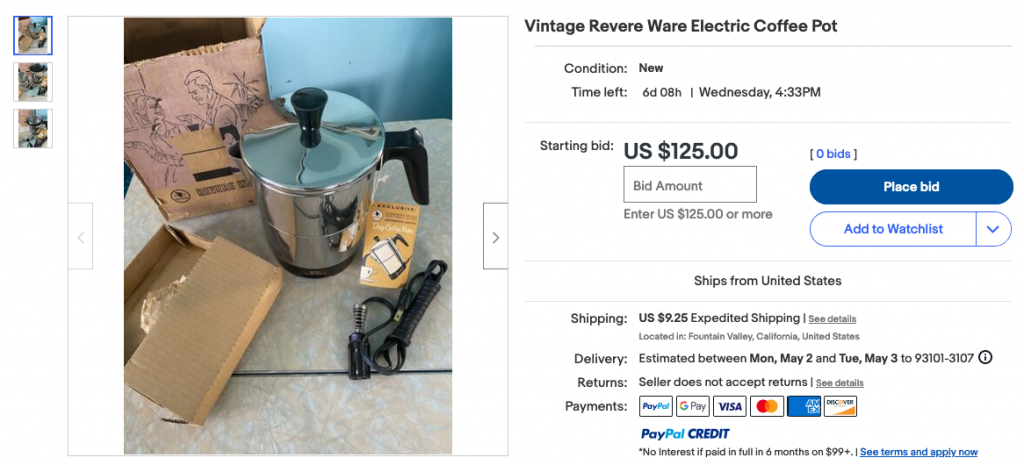
Revere copper cleaner on eBay
We get a fair amount of inquiries for the Revere copper cleaner. As far as we know it has been out of production for some time now, and isn’t available.
If you really really love it more than any other copper cleaner, there is one package available on eBay right now.
Aluminum and dishwashers; just say no
Reader Michael asks:
I have a pre-1968 Revere ware percolator and the inside of the grounds basket is black. Ive noticed this on a lot of revere ware percolators for sale. Is this normal? Is that pump assembly not stainless steel?
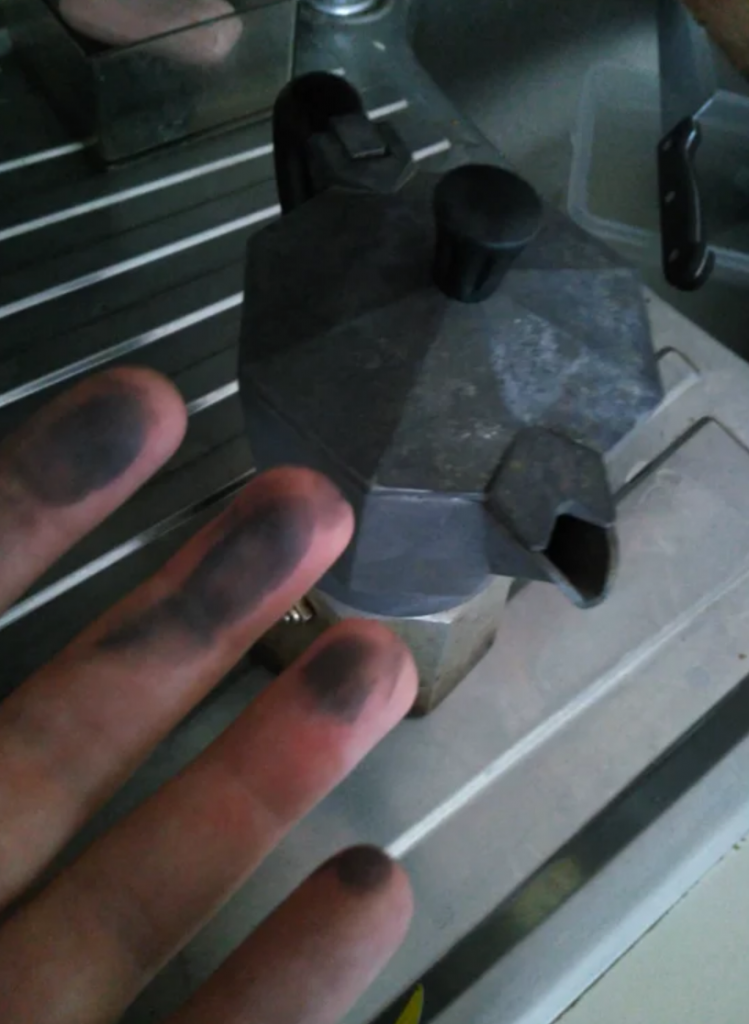
The etching of glasses in the dishwasher, and what to do about it
TL;DR to solve the etching of glassware, we are using half as much detergent and running a shorter dishwasher cycle.
For years now we’ve experienced the slow fogging of our drinking glasses. At one time we thought perhaps it was that we had bought cheap glasses, so we bought some better ones, but experience the same thing. We thought perhaps it was hard water deposits, even though we have a softener, but soaking in vinegar and scrubbing didn’t make a difference; the glasses are definitely getting etched.
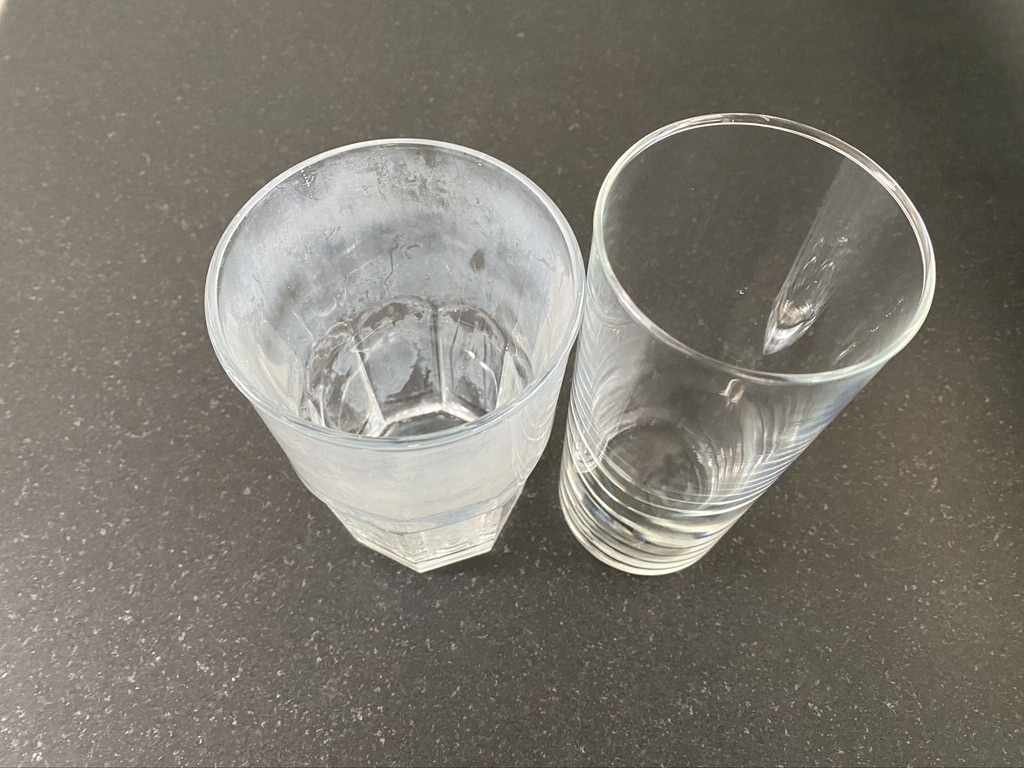
Now, to be sure, it definitely does affect some glasses and not others. But we can’t seem to figure out why. Some inexpensive glasses are not affected while other expensive ones are.
Some resources we found identified phosphates as the culprit, but most detergents have been phosphate free for some time. And we were using two of Consumer Reports top detergent brands.
Like many lingering issues, this one nibbled at us, and I just felt that it was somewhat hopeless as the things we had tried didn’t seem to make a difference.
Well, recently I decided to give it another go did some searching. Something in this article stuck me.
A senior scientist from P&G explained that a perfect glass-etching storm can happen inside a dishwasher if you have these four things: soft water, low soil load, high temperatures, and chelating agents. She went on to say, “Chelating agents, or chelants, are a major part of auto-dishwashing formulations because they form soluble complexes with calcium and other metal ions, enabling them to remove food soils and limescale, soften water, and boost hygienic cleaning action.” When you soften water as I do at my home, you remove the calcium from the water. Uh oh!
To prevent glass etching, she suggested not rinsing dishes and glasses, wash in shorter cycles, not using the pots-and-pans or sanitizing settings, and using a dishwashing product that contains zinc.
Softened water – check
Low soil – check (I’ve been aggressively scraping and rinsing plates after twice having to fix a clogged discharge tube)
High temperatures – check
Chelating agents – check
So I’ve got all the elements there for the problem. I tried to find a detergent with zinc, but no-one seems to advertise that, or even show an ingredients list for their products.
I did a little more searching and found some very interesting tips
- Use less detergent
- Use a shorter cycle
I’d read that due to energy efficiency regulations, dishwashers now run much longer than they used to in order to get the same amount of clean. Ours typically runs a 2 hours cycle, but does have a 1 hour quick cycle. It makes sense that a shorter cycle gives less time for the detergent to react with the glass, and there is less detergent so it has more of a chance of reacting with the dirt, rather than the glass.
So our approach now is to cut our detergent tabs in half, and run the quick cycle. So far, the dishes are coming out just as clean, so I am hopeful that our etching problem is also solved. I think I am going to zip tie some glasses that have previously etched in our dishwasher like I previously did with a Bakelite dishwasher test, and see what happens.
I have high hopes that this will solve our problem.
Update: After about 9 months of using half the detergent and the quick cycle, I am happy to say the glass etching seems to have stopped.
Revere Ware auction chuckle
I love the use of this stove to show cookware for sale. And that second picture, what a treasure. 🙂
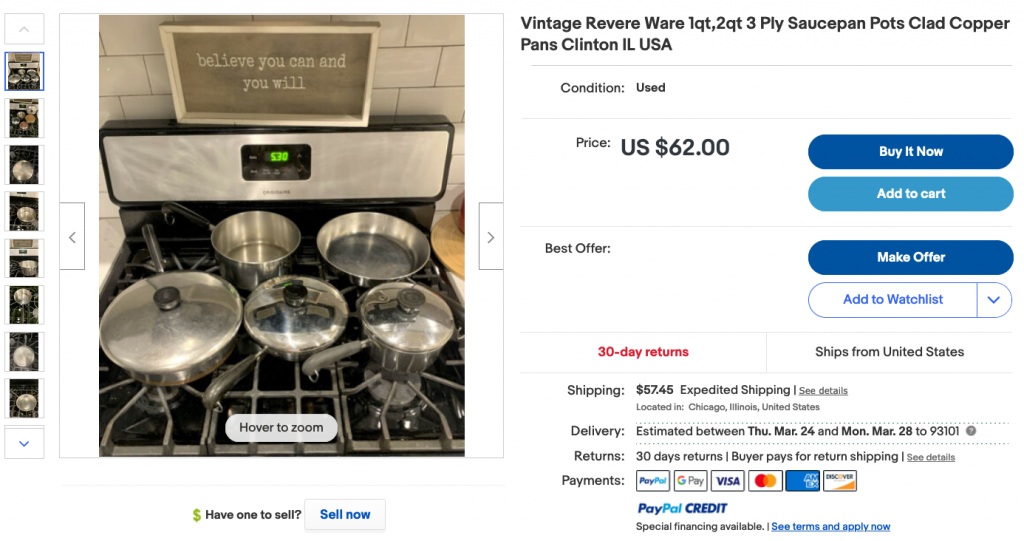
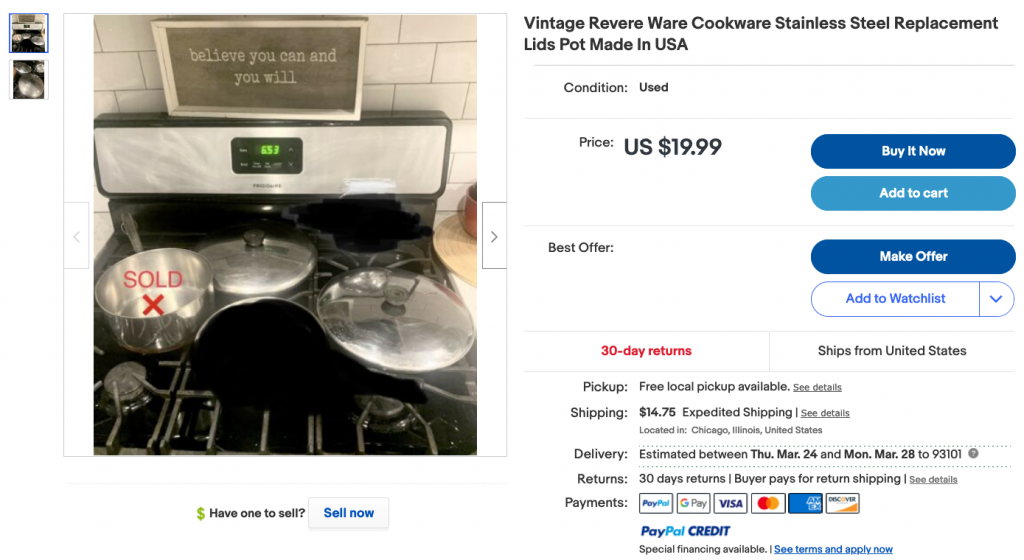

Best of Revere Ware Parts blog – More and More Revere Ware on eBay
It’s instructive to look back on October of 2012, not quite 10 years ago when I posted that more and more Revere Ware was appearing on eBay.

As you can see, at that time, I was talking about around 1,500 listing. Wow, that 10 years has done. Here is the entire graph from 2009 to the end of 2021.

As of today, there are over 15,000 listings today, 10 times more. In fact, eBay doesn’t even tell us exactly how many there are anymore:

There are 4,200 listings for just sauce pans!
1,500, how quaint! 🙂
Worn Revere Ware stamps
Reader Camille asks:
There is one piece left of a set of Revere Ware that was my mother’s and is at least 65 years old. It is definitely pre—1968, and I’m thinking that it was gifted to her in the early 1950s. The piece that’s left is the large pot and it is so old that only way you can see the stamp is with a bright light and a magnifying glass. Is this common for the older pots?

